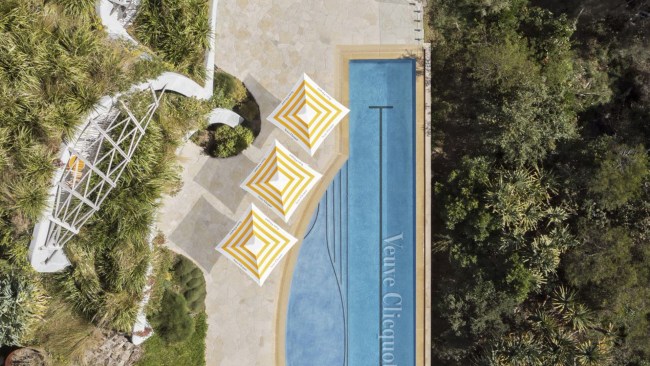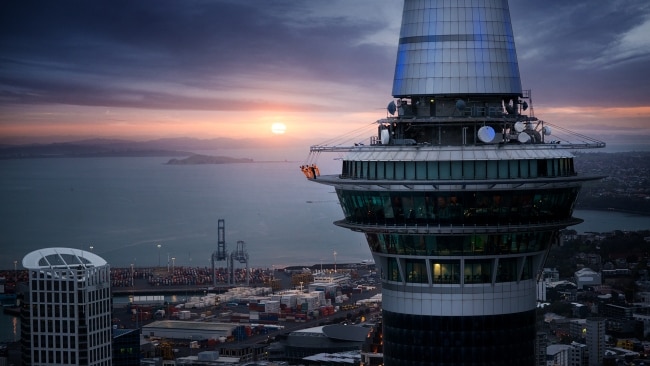Cardiff comes of age
The Welsh capital has reinvented itself as a leading sports and events city.
I AM rather embarrassingly aware that I have no real idea about Wales when I arrive by rail in the capital, Cardiff.
My head is awash with cultural stereotypes, the way it often is with a first encounter of a new city.
Through the years it's been hard to avoid the persistent English disparagements of everything Welsh. All those slurs and innuendoes and the constant drip-drip of disdain, even contempt, from comedians down the years. But I can also hear the words of Welsh poet Dylan Thomas in my head, whose lines still come to mind. I appeared as a young actor in his Under Milk Wood; unfolding in the tittle-tattle and thoughts of its inhabitants, it was written as a radio play as a day in the life of a Welsh coastal town, a buoyant and imaginative celebration of the sea, soil, wind and wantonness of Wales.
My train trip from Crewe to Cardiff is, surrealistically, a little like a Thomas "play for voices", as it's impossible not to overhear conversations in that wonderful sonorous accent. Cardiffians returning home surround me and never seem to stop chatting, easily able to drown out the Australians travelling to the capital for the first Ashes Test.
At the end of three hours of surprisingly comfortable British rail travel, I feel haunted by the slight incantatory effect of the Welsh voice, its lovely phrases and rhythms. There's a Welsh woman returning from Germany and her trilling intonations, a touch of Irish coming through, are a delight.
But nothing, neither sour English gibes about Wales nor the lovely mystical comic writing of Thomas, not even the lilting voice of my new Welsh friend, prepares me for Cardiff.
It's a hot, sticky and stifling morning when I arrive, the city restless in the summer heat. The Test is about to start at the Sophia Gardens ground, at the edge of the city, once a dump where spectators sheltered under little more than a cowshed beside the River Taff. It's easily the most controversial venue for a match between the two foes in their long history.
Press reports on the morning I arrive talk of the ground having taken on "the appearance of a Palladian palace", the transformation obviously one of Cardiff's greatest triumphs in a decade that has seen many.
Everywhere in the small city cobbles are piled on pavements, buildings wrapped in protective coverings, fenced off and taped, machinery poised to strike. The air reeks from the tumult of continual construction, the smell of Roman dust in the air, as many of the city's ancient inner-city streets are upended.
The skyline is cluttered with cranes as apartment blocks, shops and offices near completion and the city chimes with loud banter and the excitement of being one of the most progressive capitals in the new Europe.
It's also graduation day for thousands of the city's 32,000 university students and there are as many mortarboards, with their distinctive flat top and tassels, as there are hard hats worn by the construction workers.
DAILY DEALS Flights: Click here for the latest deals on flights around Australia and around the world.
I meet Paul Harris from the See Wales group for a bespoke version of his A Welcome to Wales guided day tour. The city centre is easily navigable on foot, the commercial precinct bounded on the western side by the River Taff, source of the occasionally derogatory nickname of generations of expatriate Welsh.
The Taff flows past the walls of Cardiff's extraordinary castle, a delightful and often wicked amalgam of Roman remains, Norman keep and Victorian fantasy.
"Cardiff has the feel of a work in progress," Harris says. "Twenty years ago it was all dark, a gloomy place." Back then, when the coal wharves brought the wealth that gave Cardiff its city status, there were commanding government offices in the centre and affluent suburbs. There were also hectares of derelict marshes near the water known as Tiger Bay, a second-rate shopping centre and few international hotels.
But what was once a black, smoky provincial centre has become a cosmopolitan city, the griminess vanquished under reinforced cement, foundation and render.
And there is, even for the outsider or long-time exile, a thrill about witnessing and even being part of that. Tourists are players in a changing culture, privileged to be present at a time of transition. And the visitor quickly discovers a fashionable Welsh-accented European destination with an invigorating life of its own built around cultural events and sport.
The dream ticket during my visit is, of course, Cardiff's inaugural hosting of the Ashes at Sophia Gardens, which is a lovely ground surrounded by parklands. Home county Glamorgan secured the game because it won the contentious bidding war orchestrated by the England and Wales Cricket Board. And Cardiff is determined to provide a match to remember.
Flags wave from cars, hooters blow, delighted kids with painted faces whoop and holler, the Barmy Army of England supporters is walking to Sophia Gardens singing its loony songs. A crumpled-looking fellow in an Australian supporter's cap is standing near the ground on a little bridge with a sign around his neck: "Ticket please, will swap for sister."
Every second house on the way seems to be a pub and outside each there is a long queue. Almost everybody has their face painted or hair coloured. Many are drinking the local lightly coloured malty bitter Brains SA, known affectionately as Skull Attack, though Brains Bitter is the local brewery's standard bitter and the most commonly available in Cardiff. It's a city that enjoys a drink.
I remember a few lines from the Thomas short story Old Garbo. "I liked the taste of beer," he wrote, "its live, white lather, its brass-bright depths, the sudden world through the wet brown walls of the glass, the tilted rush to the lips and the slow swallowing down to the lapping belly."
At the cricket on the fourth day, Australia is outplaying England, the pitch remains basically good, hardly of threatening pace, and England's novel plan of beating Australia with a pair of spinners lies in tatters. Australian confidence is soaring and once the baggy greens get on a roll they are rarely stopped. Time, of course, will sadly tell otherwise.
"Sport is at its heart of this city in so many ways, the population ebbs and flows with the coming and going of the fixtures," Harris says as we continue our tour across Cardiff, dodging scaffolding.
"And each match floods the streets with resilience and a sense of hope."
He points to the looming Millennium Stadium, which dominates the west end and was built to accommodate the Rugby World Cup in 1999; it's now the city's emblem. Sport tourism was the launch pad from which the city raised awareness levels and changed perceptions. By 2007, Cardiff was attracting more than 12 million visitors a year, a 31 per cent increase in just eight years.
In an inspired, almost arrogantly bold location by the River Taff, the three-tiered stadium with a retractable roof has a capacity of 74,600 and its enormous scale adds to Cardiff's sense of occasion. During the 2012 Olympics, eight football matches will be played here.
Attracting more than one million visitors a year, almost half from outside Wales, the stadium hosts the Six Nations rugby tournament, concerts by rock and pop giants (visiting acts have ranged from U2 and Bruce Springsteen to Oasis and Madonna) as well as speedway, rugby league, rallying and monster truck racing.
"There is something about this stadium that makes people who would never sing find voices they didn't know they had," Harris says of the stadium's famous rugby games and their choral displays.
Initially Millennium Stadium had its doubters, as was the case with so many of the plans for the new Cardiff. Many believed the money could have been better spent on fixing run-down estates, rising drug use and social dislocation. Some curmudgeons just hated the futuristic design of spars, masts and tension systems that loom over Cardiff's city centre, throwing multiple spires at precarious angles into the skies.
Visible from almost every precinct, depending where you stand the stadium looks like a giant cruise ship setting sail or an abandoned spacecraft from Doctor Who, waiting to be dismantled by the art department. I mention to Harris that it all seems strangely familiar and he reminds me the stadium appears regularly in the television series about that indomitable intergalactic time traveller and its spin-off Torchwood.
Both are filmed in Cardiff and scruffily dressed BBC film crews are a familiar sight; drinkers in the city centre have witnessed squads of Cybermen marching past their pubs. In fact, Cardiff's alien invasions, time machines and sonic screwdrivers have made it the science fiction capital of Europe, celebrated for its so-called Doctor Who tourism.
Cardiff's popularity as a sci-fi destination has even prompted the hotel where I am staying, the four-star Park Plaza, to offer a special Doctor Who package that includes tickets to the phenomenally popular Doctor Who Up Close exhibition at Cardiff Bay and a remote-controlled Dalek toy in your room.
But for all the futuristic excitement and the attraction of big sporting and cultural events, Cardiff is still recognisably a historied city. It celebrates its layers and textures, laneways and different cultural precincts, and is laced with ornately glass-roofed Victorian and Edwardian arcades that lead off High Street and St Mary Street. Its sense of self does not reside in any one building but in the lovely romantic mix. Wandering around is absorbing, like being inside a long romantic historical novel. Everywhere I walk are memorials, plaques, pieces of the past: crumbling Roman walls, medieval gates, Georgian sculpture, industrial clocks and pieces of embankment chipped back to reveal clean Victorian stone.
Harris and I traipse around Cardiff Central Market, where the old city jail once stood. It's a Victorian glass-roofed hall where old-time butchers and fishmongers in white coats and fruiterers in vaudeville-style hats and aprons are interspersed with stalls of fruit preserves, lemon curd and homely knitwear.
He takes me to Spillers, an unassuming, vinyl-dominated record shop in the nearby Hayes shopping area. Spillers is the oldest music emporium in the world, opened in 1894 by Henry Spiller when a gramophone player cost about a year's wages.
In the street outside we are elbowed aside by a passing gang of bricklayers and their piled-up wheelbarrows, and dodge a Nissan truck overloaded with cement bags; this part of the city is prime real estate.
After a vast redevelopment scheduled to finish by the end of the year, Cardiff will sport the biggest shopping centre in Britain, a £stg675 million ($1.3 billion) development called St David's 2 that will include shops, restaurants, cafes and the Hayes Apartments, 304 homes with rooftop courtyards that will provide green space in the heart of the city.
The symbolism of the new rising out of the old, scruffy and untidy though it seems at the moment, is potent in a city with such a strong sense of its own history.
Thomas wrote, in a preface to his Collected Poems, of a shepherd who, when asked why he made, from within fairy rings, ritual observances to the moon to protect his flocks, replied: "I'd be a damn fool if I didn't!" And wherever you go in Cardiff people seem to be saying the same thing about how much they love the regeneration of their city.
Graeme Blundell was a guest of Emirates and Visit Britain.
Checklist
Emirates operates double daily services between Sydney, Brisbane and Perth and Dubai and thrice-daily services between Melbourne and Dubai. One service daily from Sydney operates via Bangkok; one service daily from Melbourne and Brisbane operates via Singapore.
Emirates offers five daily services between Dubai and London Heathrow, and three daily services between Dubai and London Gatwick. Emirates also has good connections from Dubai to Manchester, Newcastle, Birmingham and Glasgow. Fares ex Sydney from $1975, taxes included. More: 1300 303 777; www.emirates.com/au.
Paul Harris's A Welcome to Wales day tour costs £45 a person or £100 for a family of up to five, including lunch and admissions. More: www.seewales.com.
A new series of Torchwood, set in Cardiff, starts on ABC2 on September 18, 8.30pm.
www.visitbritain.com.au
www.visitwales.com



